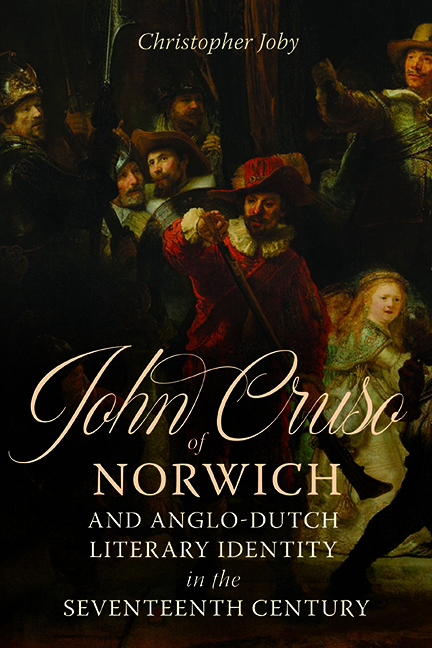Book contents
- Frontmatter
- Dedication
- Contents
- List of illustrations
- Acknowledgements
- Author’s note
- Abbreviations
- Prologue
- 1 Intrat John Cruso
- 2 John Cruso’s school days
- 3 John Cruso’s early adult life
- 4 Cruso’s elegy to Simeon Ruytinck (1622)
- 5 Cruso the English poet
- 6 1632 – Cruso’s annus mirabilis
- 7 Cruso the translator
- 8 Cruso’s 1642 Dutch verses: praise and lamentation
- 9 Cruso and the English Civil Wars
- 10 Cruso the Epigrammatist
- 11 Cruso’s final years
- Epilogue
- Appendix 1 Poems by John Cruso
- Appendix 2 Liminary verses in John Cruso’s English publications
- Bibliography
- Index
- Studies in Renaissance Literature
3 - John Cruso’s early adult life
Published online by Cambridge University Press: 26 May 2022
- Frontmatter
- Dedication
- Contents
- List of illustrations
- Acknowledgements
- Author’s note
- Abbreviations
- Prologue
- 1 Intrat John Cruso
- 2 John Cruso’s school days
- 3 John Cruso’s early adult life
- 4 Cruso’s elegy to Simeon Ruytinck (1622)
- 5 Cruso the English poet
- 6 1632 – Cruso’s annus mirabilis
- 7 Cruso the translator
- 8 Cruso’s 1642 Dutch verses: praise and lamentation
- 9 Cruso and the English Civil Wars
- 10 Cruso the Epigrammatist
- 11 Cruso’s final years
- Epilogue
- Appendix 1 Poems by John Cruso
- Appendix 2 Liminary verses in John Cruso’s English publications
- Bibliography
- Index
- Studies in Renaissance Literature
Summary
In one of his epigrams (no. 53) published in 1655 John Cruso tells the story of two Dutchmen, or possibly Flemings, Klaas and Jan, who travel by road between London and Norwich [Noorde-Wijck]. Klaas is clearly more cunning than Jan for he manages to trick his companion into carrying his coat for most of the journey between England's two largest cities. It is a journey that Cruso himself would often have made, either by road, or by boat via Yarmouth, on business as a cloth merchant and hosier, and in his capacity as an elder of the Norwich Dutch church. In the years after leaving school, his name appears in the London Dutch church records, which may suggest that he lived in the city for several years. However, by the second half of the 1610s he was most probably living once more in the city of his birth, Norwich. Here, he was a busy man, participating in both the civic and Dutch Stranger institutions. He inherited his father's freedom, got married, witnessed the baptism of his two eldest children and set up home in the parish of St Andrew in the Great Ward of Wymer to the south of the Wensum. He was probably also honing his skills as a poet. In 1622, he published his first Dutch verse in a collection of Latin epicedia and Dutch elegies [klacht-ghedichten] to the late minister of the Dutch church in London, Simeon Ruytinck (d. 1621). Cruso's elegy, which is analyzed in the next chapter, introduced him to the world as an author of Dutch Renaissance verse. This chapter takes us on a journey from Cruso's departure from Norwich Free Grammar School to London and back to Norwich to the eve of the publication of his 1622 elegy.
JOHN CRUSO IN LONDON
Cruso probably left Norwich Free Grammar School in about 1607 or 1608, armed with a humanist education and a toolkit of rhetorical devices that he would operationalize throughout his literary career. It must be admitted, however, that until 1613 we hear nothing of Cruso in the records. In that year the name ‘Jan Cruso’ appears not in Norwich, but in the register of members of the London Dutch church.
- Type
- Chapter
- Information
- Publisher: Boydell & BrewerPrint publication year: 2022



